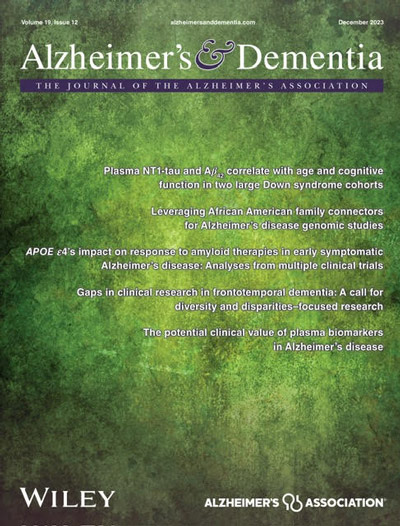Blood biomarkers in Down syndrome: Facilitating Alzheimer's disease detection and monitoring
IF 13
1区 医学
Q1 CLINICAL NEUROLOGY
引用次数: 0
Abstract
Blood-based biomarkers continue to be explored for disease detection, monitoring of progression, and therapeutic outcomes as the diagnostic determination of Alzheimer's Disease in Down Syndrome (DS-AD) remains challenging in clinical settings. This perspective highlights the current status of this effort. Overall, amyloid (A), tau (T), and neurodegeneration (AT[N]) blood-based biomarkers have been shown to increase with disease pathology for individuals with DS. Phosphorylated tau biomarkers (p-tau217, p-tau181) have been consistently shown to track disease progression for DS-AD and are likely good candidates for use in clinical settings. Biomarkers of inflammation (glial fibrillary acidic protein) also show promise; however, additional work is needed. Findings from stability work of blood-based biomarkers conducted among non-DS also support the potential longitudinal utility of biomarkers such as neurofilament light chain and p-tau181 in DS. Gaps in our knowledge are highlighted, and a potential role for sex differences in biomarker outcomes is noted, along with recommendations for determining the appropriate context of use when translating biomarkers into clinical applications.唐氏综合征的血液生物标志物:促进阿尔茨海默病的检测和监测
由于唐氏综合征阿尔茨海默病(DS-AD)的诊断确定在临床环境中仍具有挑战性,因此人们继续探索基于血液的生物标志物,以用于疾病检测、进展监测和治疗结果。本视角重点介绍了这一工作的现状。总体而言,淀粉样蛋白(A)、tau(T)和神经变性(AT[N])血液生物标志物已被证明会随着唐氏综合征患者的疾病病理变化而增加。磷酸化 tau 生物标志物(p-tau217、p-tau181)已被证实可追踪 DS-AD 的疾病进展,并有可能被用于临床。炎症生物标志物(神经胶质纤维酸性蛋白)也显示出良好的前景;但是,还需要做更多的工作。在非DS患者中开展的基于血液的生物标志物稳定性研究结果也支持神经丝轻链和p-tau181等生物标志物在DS中的潜在纵向用途。报告强调了我们的知识空白,指出了性别差异在生物标记物结果中的潜在作用,并建议在将生物标记物转化为临床应用时确定适当的使用环境。
本文章由计算机程序翻译,如有差异,请以英文原文为准。
求助全文
约1分钟内获得全文
求助全文
来源期刊

Alzheimer's & Dementia
医学-临床神经学
CiteScore
14.50
自引率
5.00%
发文量
299
审稿时长
3 months
期刊介绍:
Alzheimer's & Dementia is a peer-reviewed journal that aims to bridge knowledge gaps in dementia research by covering the entire spectrum, from basic science to clinical trials to social and behavioral investigations. It provides a platform for rapid communication of new findings and ideas, optimal translation of research into practical applications, increasing knowledge across diverse disciplines for early detection, diagnosis, and intervention, and identifying promising new research directions. In July 2008, Alzheimer's & Dementia was accepted for indexing by MEDLINE, recognizing its scientific merit and contribution to Alzheimer's research.
 求助内容:
求助内容: 应助结果提醒方式:
应助结果提醒方式:


